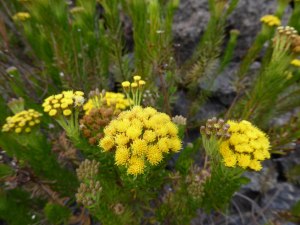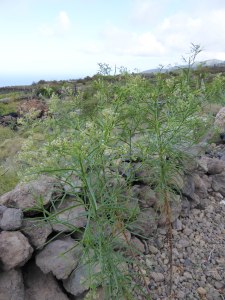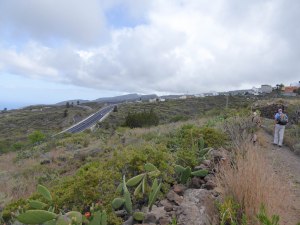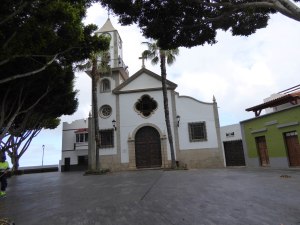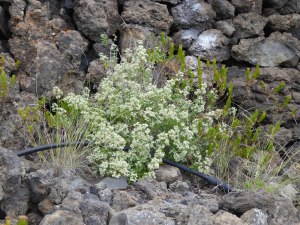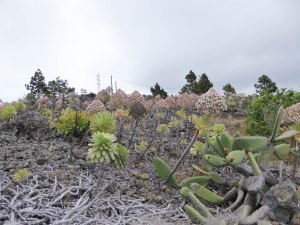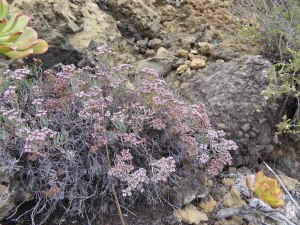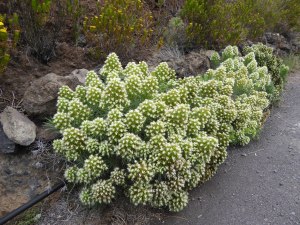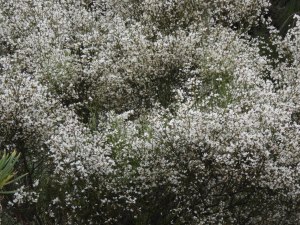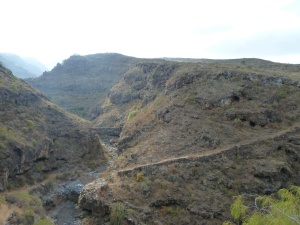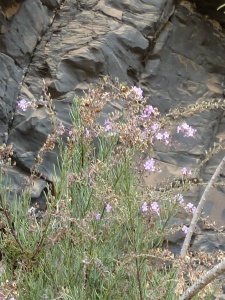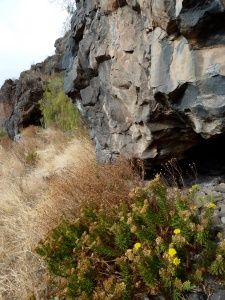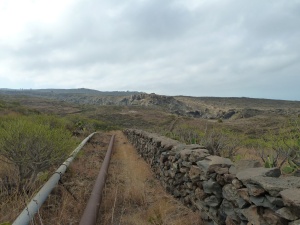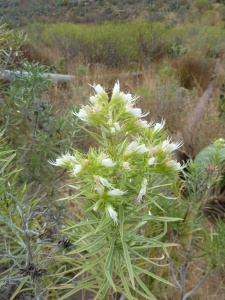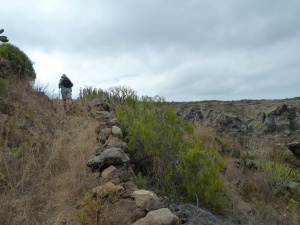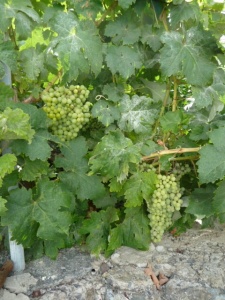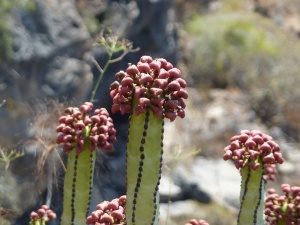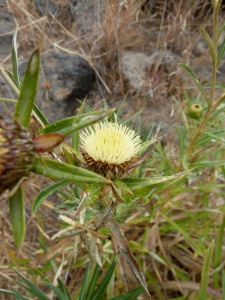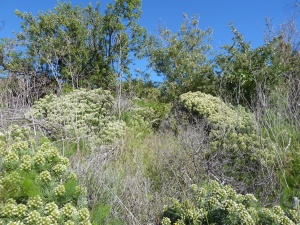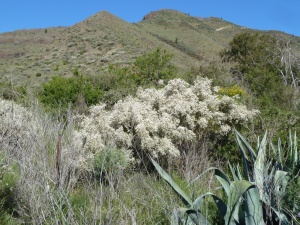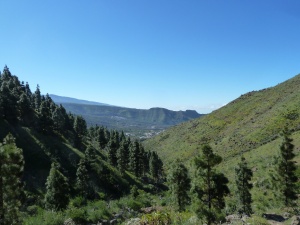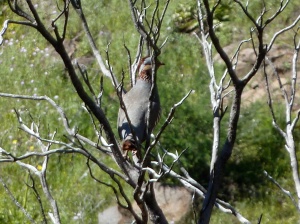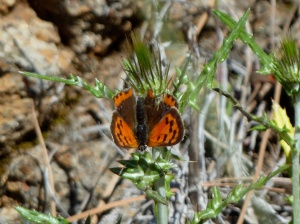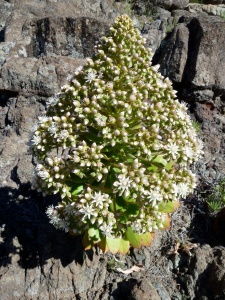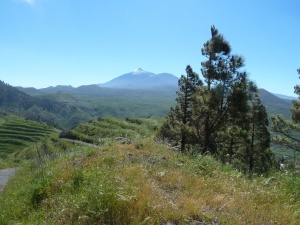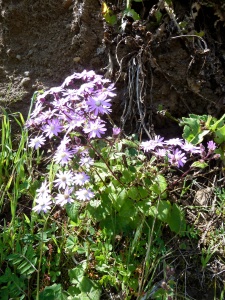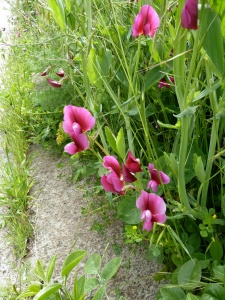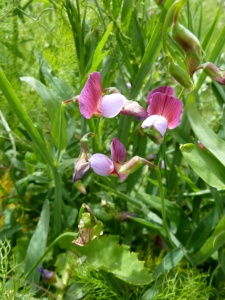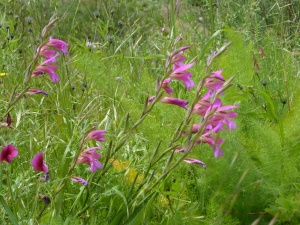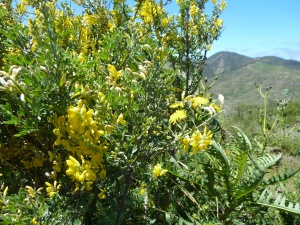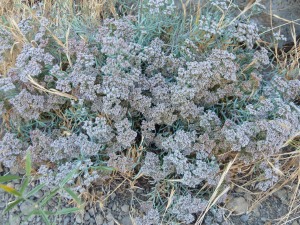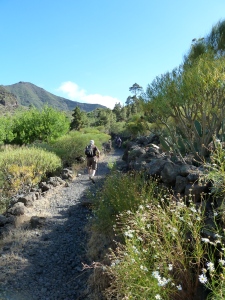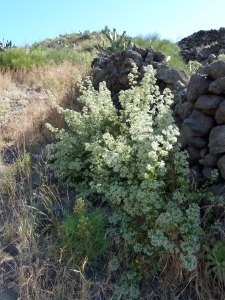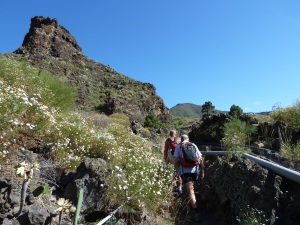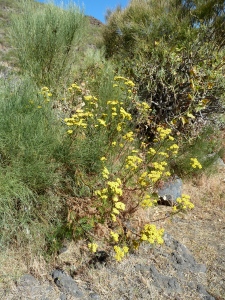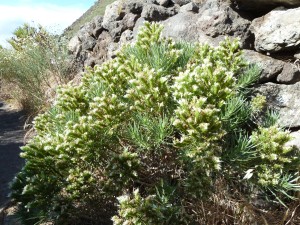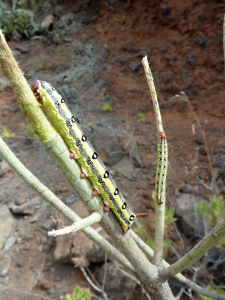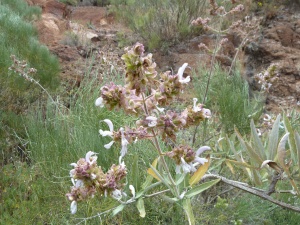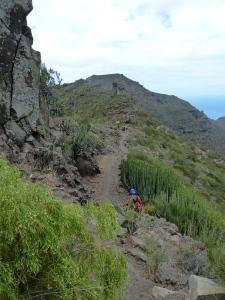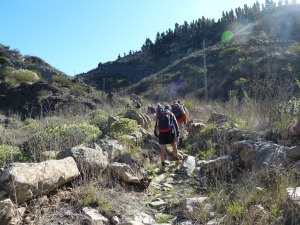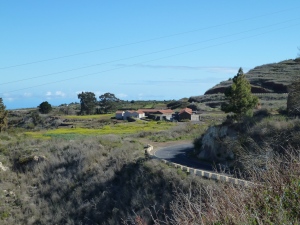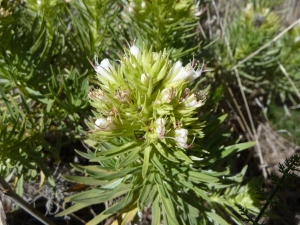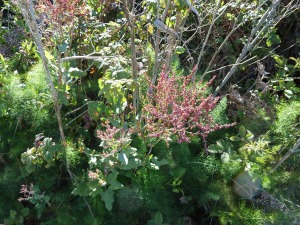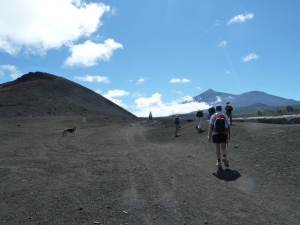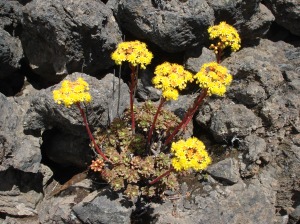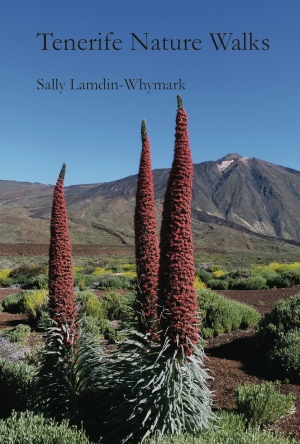Blog Archives
Camino real route from Guia de Isora to Arguayo and return via Chiguergue
I have lived in Guia de Isora area for 11 years, and walked a great many different footpaths in the area, but have long wanted to walk a part of the south Camino Real (Royal Road) from Guia to Chio. However, I did not know where the Camino Real went after Chio and was delighted to see the route from Guia de Isora as far as Santiago del Teide posted in Wikiloc.com by user ‘tinijoma’. So I planned a walk which followed the Camino Real as far as Arguayo and returned by other footpaths, already known to us, slightly higher up.
The Camino Real is part of a network of ‘royal roads’ which were directed by the king to be built by the landowners who had been given large areas of land as rewards for participating in the conquest of the island. They were the motorways of the day, linking all the main settlements with wide cobbled paths, enabling communication and trade.
I walked this route on May 25th with two friends but had not got around to doing a blog about it till now, but wanted to share it as it was an interesting walk both culturally and botanically.
A lot of the botanical interest was that it was the flowering time of the Tenerife endemic Giant Houseleeks – Bejeques in spanish – (Aeonium urbicum ssp meridionale). These plants are short-lived perennials which produce a rosette of succulent leaves on a thick stalk, and may survive several years before producing a large head of flowers and then dying. They grow on the recent lava flows, and other rocky areas, where few other plants are able to survive. Some years there are relatively few in flower, but this year there are huge numbers. Jeff Ollerton, an environmental scientist who does research in Tenerife believes the years when there are a lot in flower occur after a dry winter, and is doing a study to test this hypothesis.
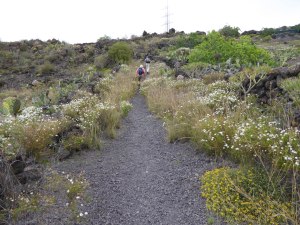
The Camino Real starting the ascent to Arguayo with Tenerife Birds Foot Trefoil (Lotus campylocladus) and marguerites (Argyranthemum spp) along the route
We started our walk from the end of the Avenida de la Constitucion, which is a dead end road on which the Health Centre (Centro de Salud) and a couple of schools are found. My friends call it the ‘road to nowhere’! So it is easy to park towards the far end! We started by heading downhill on a track which appeared at first to be a private drive, not far from the end of the road. However, the track continues beyond the house it passes on a bend and continues down to the TF-82 main road between Guia de Isora and Chio.
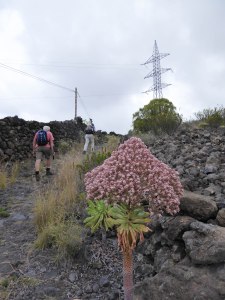
This specimen of the Giant Houseleek (Aeonium urbicum ssp meridionale) beside the path is a particularly strong pink colour
On reaching the road I realised that instead of crossing it onto another track below the road we had to turn right and walk along the road for some 100m before turning off left onto the Camino Real, which was a single lane tarmac road at first, changing later to dirt track, and later still, a footpath. If you are not happy walking along a fairly busy road (though not so busy as it was before the opening of the new road TF-1) for this distance you could start the walk up in Chiguergue and avoid it, though this would shorten the walk also.
The Camino Real follows a route below the old TF-82 road and above the new part of the TF-1 road between Guia de Isora and Chio, with some good views down to the new road. Then it climbs steeply up to the village of Chio with huge cobble stones, but not always in place, so this stretch was a bit rough underfoot. Then we walked through the village passing the church on our left and continuing roughly straight on till we left the other side of the village. Then the route grew closer to the new road, ending up at the top of the embankment of the slip road off the road to the Chio junction, finally crossing the TF-82 at a diagonal as it goes down to cross the TF-1.
Then the ascent towards Arguayo began, climbing over malpais, joining the TF-375 road to Arguayo (now quite quiet, with the new road and tunnel), crossing it, and crossing back onto a track past some houses, and joining tarmac as we reached and crossed the TF-375 road again to leave the Camino Real and start our return.
We did not go into the village of Arguayo, where you can find shops and bars if you want some food or drink, and could go to visit the pottery museum where you can watch demonstrations of traditional local pottery making. Instead we turned right and walked down in front of the cemetry and took the next track on the left. We followed this track, and the path that continued where the track stopped, through to Chio, taking care on the downhill slope into the village.
Arriving at the TF-82 where it goes through the top of Chio, we turned left and walked along the main road for some hundreds of yards till nearly at the end of the village, just before the pharmacy, we turned left up an initially steep narrow road past Chio’s cemetery. We continued along the narrow road, tarmac at first, then track, then cobbled footpath, until we reached more tarmac just before the village of Chiguergue.
We reached the junction with another small tarmac road, went right and continued on the same road through the top of the village and out the other side. Note that if you want refreshments in Chiguergue you need to go to the bottom of the village. The narrow tarmac road continues towards Aripe through countryside with odd farmhouses. Immediately under a high wall of one of these houses we took a path which wound its way past a vineyard and other fields down to the road where we parked. This path is not well marked and difficult to describe so you need the GPS track to find it easily.
The GPS track of our walk can be found at the link below:
http://www.wikiloc.com/wikiloc/view.do?id=13445979
The route is 14.59km / 9.1 ml long with 510m /1675ft of ascent and descent and took 3 of us 4.5 hours to complete.
A flowery spring walk from Tamaimo up the Santiago valley
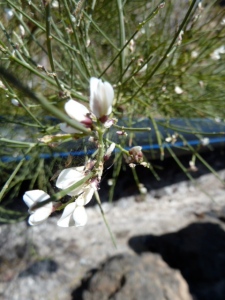
A Retama flower (Retama raetam) beside the irrigation channel next to the path. The Retama bushes had very few flowers in this area this year.
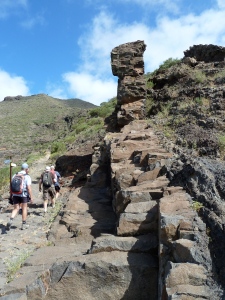
The path out of El Molledo passes by this wide dyke of (formerly!) molten rock intruded into existing rock.
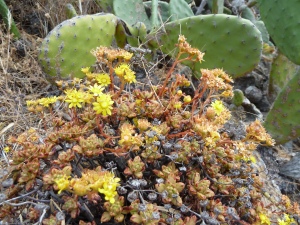
Aeonium sedifolium growing on another dyke running along the top of the ridge to the north of Tamaimo
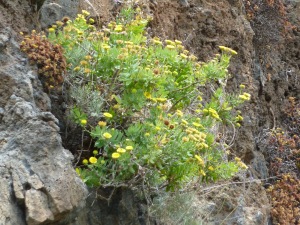
Tenerife samphire (Vieraea laevigata) growing on the rocky cliffs above the path descending to Tamaimo. It is a Tenerife endemic found only in the Teno region
These last two weeks I have been very busy and I am going away again in a couple of days, so I do not have time to write a full description of the walks I have done recently which have been so enjoyable with all the spring flowers to see. So I am just posting the photos to give my followers an idea of the flowers that I have seen.
Pleasant walk from Valle de Arriba
This walk is a pleasant one, with a variety of different landscapes, some nice views but mainly gentle climbs and descents. It is in a figure of eight, so although it is a fairly long walk, it could be cut to less than half by making a circle instead of an eight. The full walk is 15.7km/9.8miles, with 454m/1490ft of ascent and descent, and took us 4 hrs 38 mins. If you did just a circle from Valle de Arriba it would take just 2 hours, 5.9km/3.7miles with only about 200m/660ft of ascent and descent.
In Valle de Arriba we parked near an electricity pylon in the road just beyond the church. The road is wider there because of the pylon so there is some space for parking. From there we walked up the road in a northerly direction, ignoring a turning right and keeping straight on to the end of the tarmac. Then we turned to the right on a track, then soon after, left up a slope onto the path. The path goes up a valley in a northerly direction. This area was badly affected by the 2007 forest fire and you can still see the blackened skeletons of the shrubs that were burnt. However, new young shrubs are growing up in their place, and the signs of birdlife, shows that the area is recovering. There were a lot of Lesser white bugloss (Echium aculeatum), the local endemic form of the Viper’s bugloss, up this valley, flowering at the moment and interesting the bees. There was also a fine clump of Retama (Retama raetam) not far from the path, all in flower, but too far away for us to enjoy the scent.
At the top of this path you reach a road, the one from the Restaurant Fleytas to San Jose de los Llanos and La Montañeta. We went to the right on a faint path with cairns to climb up to the track that goes round the mountain to the right, Mt de Tamaseche. However, the path up there is quite steep and might not suit everyone, so if you prefer you can go right and walk along the road for 0.5km/0.3m till you get to a roundabout and turn right. If you climb the steep path to the track, you go left on the track and circle the mountain, with the road below you till you get to the same level at the roundabout where there is a large old pine tree. Along the track are some plants and flowers of interest, including Madeiran sorrel (Rumex maderensis), Cineraria (Pericallis echinata) and Sticky broom (Adenocarpus foliosus), all of which were in flower. Turn right here and go up a track. After the initial stretch with the tree-covered mountain to your right, the views open out, including a good view up to Mt Teide.
After walking about 900m/1000yds up the track from the roundabout, (about 1hr of walking from the start in Valle de Arriba), you reach a crossroads of tracks. This is the crossing point of the figure of 8, and if you want a short walk turn right here. Otherwise go left. The track goes on past open fields and then enters the edge of a pine-dominated woodland with evergreen shrubs of Faya (Myrica faya) beneath them. Continue along this track till you get in sight of a substantial white-painted building, fenced off with chain-link fencing. Before you get to this building, which is a drinking water reservoir, turn right onto a track doubling back to your right.
After 5 minutes walking along this track, (about 0.5km/0.3m) start looking to the left for a large cairn and the start of a footpath, with stones lined up each side. If you miss the path at first keep looking to the left for it as it is in sight of the track for some way, but move onto it as soon as you see it as the track turns to the right and you want to be going to the left with the path.
This path is part of the PR-TF-43 complex and you are on the path which goes from San Jose de los Llanos to Chinyero. It has yellow/white standard signage and parallel paint marks. After about 30 minutes walking through pleasant forest the path goes up a steep slope of black ‘sand’ to arrive at a track near the Volcan Negro on the left. There are views to Mt Teide and Pico Viejo straight on. A covered channel crosses the landscape of black ‘sand’ parallel with the track. This is the Vergera canal which takes water from ground-water resources in the Barranco de Vergera above Los Realejos in the north to Guia de Isora. A signpost with the yellow/white livery directs you right, over the canal, towards Chinyero.
We passed another pleasant 30 minutes walking across the black ‘sand’ in amongst trees, and past rocks with orange stringy lichens and yellow Houseleeks (Aeonium spathulatum) flowering among the rocks. We had gone straight on at a path junction with a left turn signed to Arenas Negras and Garachico, and then shortly afterwards we had reached a signpost pointing in two directions for the Chinyero circular path. Here we went right, but we did not continue with the yellow/white path where it went left off the track after a few yards, instead we stayed on the track to take a shortcut, till a yellow/white marked path crossed the track after 15 minutes of walking, where we turned right to start our descent.
We stayed on the yellow/white marked path, now heading for ‘Partidos de Franquis’ till we got back to the cross roads of tracks where our figure of 8 joins in the middle. We turned left and walked along the track taking the 2nd track on the left, after 12 minutes of walking. We then followed that track till a T-junction of tracks, turned right and met a narrow tarmac road which winds its way up to the end of the Chinyero lava. Going right on the tarmac we soon spotted our path on the right which took us back to Valle de Arriba by a more direct route than the road. Once in the village, and on tarmac we continued downhill, did a sharp right turn, then a left, left again and we were back to the cars.
You will find a downloadable GPS track of the walk, on maps at the following site:
